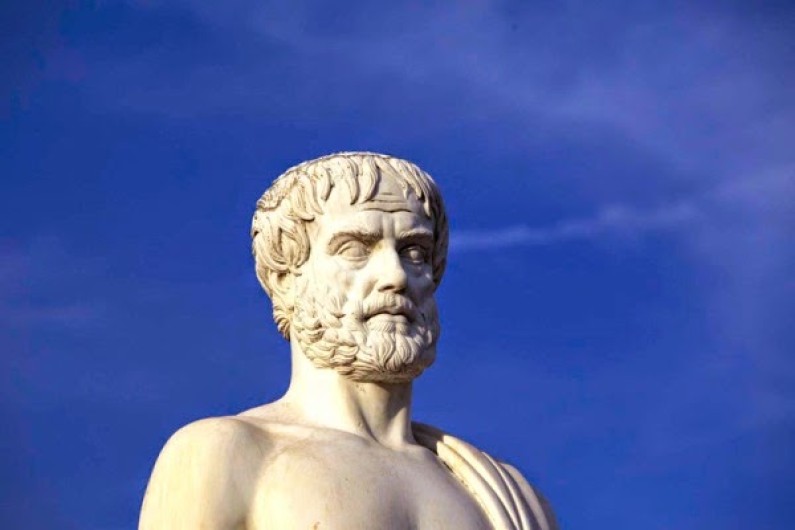
In his time, the Greek natural philosopher Aristotle (384-322 B.C.) was the last word when it came to science. Of the many ideas Aristotle shaped, two were the four classical elements and the origins of metals. These are the two ideas that will be discussed in this article.
The Greeks and people of medieval philosophy had come to the conclusion that the world was essentially made of four elements–Earth, water, air, and fire. The original idea of this is credited to the natural philosopher Empedocles, who called them “roots.” However, Aristotle further developed the idea by naming them elements and using common reason to assign the types of matter their own properties.
Of the four qualities, hot and cold are active qualities, while moist and dry are passive. Only four combinations of these qualities are ever possible at one given time. This is because no substance can have both of the active or passive qualities at once. For example, it would be a paradox to have a substance that was both moist and dry, or holding both of the passive qualities.
There are other properties as well, such as density, hardness, viscosity, and color. However, these are considered by Aristotle to be secondary. Secondary qualities are dependent on the primary qualities. For example, it is an excess of dry that makes a material hard or an excess of cold that makes a material dense.
Aristotle was more interested in the qualities of substances. He was not a chemist and had little knowledge or interest in the different types of matter. However, alchemists who followed his work put greater importance on the elements.
Earth is basically what the planet is made up of. In Aristotle’s model of the order of the universe, Earth is the base of the world followed by the other elements. Earth is a solid, making it cold and dry. Moreover, it cannot be evaporated into another element like water can.
Water is a liquid, making it cold and wet. It is the opposite of fire, explaining why fire disappears when doused with water. It was the first of the four substances to be deemed the “prime matter,” the one element from which the other elements are formed. According to legend, the world’s first natural philosopher, Thales, came up with this proposition while walking the hills and finding fossilized seashells. From this source, he correctly induced that the hills must have at one point been under water and that perhaps once the whole world came from water. However, he expanded upon that concept and theorized the hills were also once water (along with the whole world) and morphed from water into Earth. In Aristotle’s model of the order of the universe, the Earth is covered with a layer of water before a layer of air. That is why rocks (Earth in an elemental form) sink to the bottom of water and air bubbles rise to the surface. Thus, it is generated from air.
One of Thale’s followers decided that the prime matter was not water. Anaximenes decided that the fundamental element, the prime matter, is actually air. He believed this because of air’s neutrality and its relationship to the soul in the mysticism of the time. In one instance, he claimed, “[Air] differs in essence in accordance with its rarity or density. When it is thinned, it becomes fire. When it is condensed, it becomes the wind, then clouds. When still more condensed, it becomes water, the earth, then stones. Everything else comes from these.” Air is a form of gas. It is hot and wet because a gas is an evaporated liquid. Air is the opposite of Earth, just like water is the opposite of fire. They oppose each other. In the order of the world, a layer of air, starting with a low-level of vapor, covers the earth with the layer of water.
Fire is neither solid, liquid, nor gas, but rather is considered a form of pure energy. Its opposite is water, which explains why the water does not remain water after dousing the fire. The moistness and coldness of the water have a destructive reaction with the qualities of fire–dry and hot. Fire was also once considered the prime matter by one of Thale’s disciples. When Persia invaded Iona, Thale’s home city-state, Ephesus, allied itself with the enemy for safety. Thale’s disciple, Hereclitus, decided that the universe was in a constant state of change and convertibility while still “staying the same” or rather preserving itself. In a way, his ideology was similar to what we believe today as far was the Mass-Energy Equivalence. Although scientists of the time dismissed him, his hypothesis was well-liked by the Persians, who believed fire to be a symbol of the Lord of Light, Ahura Mazdã, and had a great reverence for the element.
Returning to Aristotle, he believed in the interconvertability of matter, meaning that he believed anything could be turned into anything else, even spontaneously. According to him, whenever a chemical reaction was performed, the two original materials would either destroy each other due to opposing properties (such as the active hot and cold) or would create something new when the properties were similar (such as dry and dry.) However, he believed that when similar properties combined to create something new, the original reactants no longer existed, and a new, homogeneous substance was created. This was harmful to chemistry, as it encouraged the idea that proportions do not matter and reactants need not be measured. Any observed properties of a substance could also be changed, even mass. Aristotle believed that it was the form of the substance, not the chemical composition, that determined itself. In fact, his work implied that there is no such thing as internal composition or structure of a substance. By changing the properties alone – the only thing Aristotle, a biologist at core, really tended to focus on – and the ratios of said properties, anything could be turned into anything else, no matter what.
Moving on from the elements, Aristotle is also famous for his explanation of the formation of metals and their own sort of interchangeability. Metals “grew” just like plants or animals. Both the sun and the Earth itself release “exhalations,” one moist and one dry. When two exhalations are imprisoned within parts of the Earth, two new substances are formed called fossils, which are preserved remains or traces of animals, plants, and other organisms from the past, and metals. Metals are formed from the moist exhalation trapped underground, particularly in rocks to explain the necessary separation of ore. The dryness of the rocks compresses the moistness of the vapor into a solid. After condensing, the new substance is congealed into metal by coldness. This is a logical conclusion because metals melt back into a liquid state when they heat.
Purity of a metal is determined by how much of the element earth the metal contains. The more earth put in a metal, the less pure it is and the easier it is to rust and harder it is to properly melt. An example of a metal with much earth left in it is iron. That is why iron rusts so easily and why it, while soft, is hard to melt down and make malleable. Gold is the purest form of metal with virtually no earth in it but rather all water. Water cannot be simply converted into gold by some easy process of adding dry, Aristotle assured alchemists, because it needs the difficult and rare process of both condensation and congelation within the correct amount of time.
Aristotle’s ideas and those of other preceding natural philosophers he further developed seem ridiculous today, but in his time, his books were a revolutionary synthesis of different scientific disciplines such as biology, chemistry, meteorology, metaphysics, and more. His theories seemed reasonable and were widely accepted because they made the world rational, which fit in with religion. His design of the world implied divine architecture and that everything in the world was working to direct purpose.
That brings up one of the major differences between alchemy and modern-day chemistry. Alchemists and natural philosophers brought about the first-ever scientific form of thinking by using logic and observations of surroundings to come up with explanations, trying to find a cause that was not simply mysticism or religion. However, they relied on just logic instead of testing their hypotheses to see if they were true. This and the focus of keeping the world in a divine order instead of atheistic and chaotic allowed Aristotle’s theories to not just slip through but become the most accepted and loved until the late Middle Ages.
Blog by Emma Eisenberg


